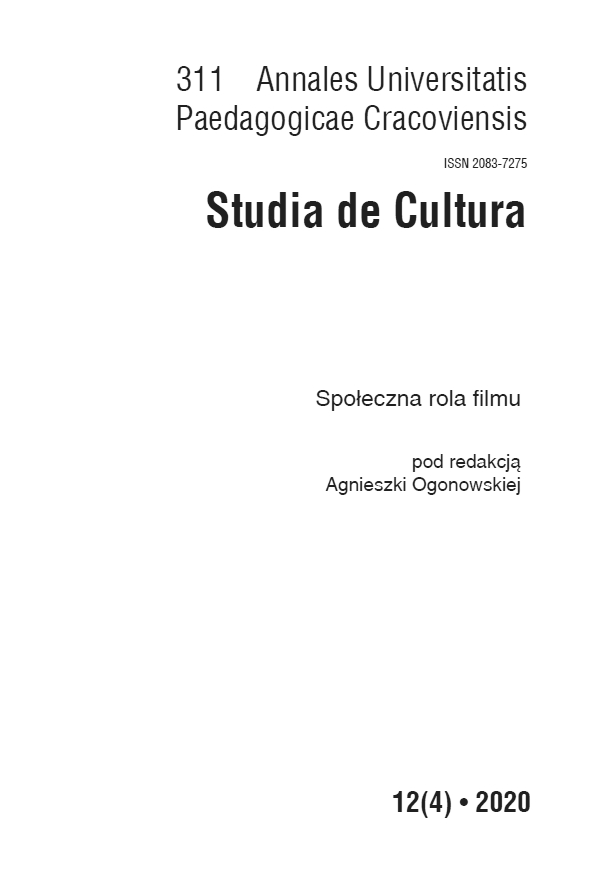Abstract
Thanks to social media, paid VOD services go beyond their borders and reach a wider audience, increasing their impact scope. Instagram is a tool which allows the owners of VOD services to maintain interaction with young viewers, who are the main users of this medium. The paper presents the results of a comparative analysis conducted with the use of netnography and media content analysis, posts published in 2019 on profiles connected with the most popular paid VOD services in Poland: Netflix, HBO, Ipla and Player.
References
Alhabash Saleem, Ma Mengyan. 2017. „A Tale of Four Platforms: Motivations and Uses of Facebook, Twitter, Instagram, and Snapchat Among College Students?”. Social Media + Society. https://doi.org/10.1177/2056305117691544. (dostęp: 17.11.2019).
Akyıldız Oezguer. 2019. „Framework for Video-On-Demand Industry in Sweden”. Helsinki: Arcada University of Applied Sciences. https://www.researchgate.net/ profile/Oezguer_Akyildiz/publication/ 333682541_Framework_for_ Video-On-Demand_industry_in_Swedenpdf/links/ 5cff829c4585157d15a21932/Framework-for-Video-On-Demand-industry-in-Swedenpdf.pdf. (dostęp: 19.11.2019).
Całek Agnieszka. 2018. Analiza obrazu. Studium przypadku Anny i Roberta Lewandowskich - pierwszej pary Instagrama. W: Metody badań medioznawczych i ich zastosowanie. Agnieszka Szymańska, Małgorzata Lisowska-Magdziarz, Agnieszka Hess (red.). Kraków. 361-378.
Duggan Maeve. 2015. „The Demographics of Social Media Users”. Pew Research Center. https://www.pewresearch.org/internet/ 2015/08/19/the-demographics- of-social-media-users/. (dostęp: 10.11.2019).
Goczał Beata. 2019. „Netflix najpopularniejszym płatnym serwisem VOD w Polsce, HBO Go przed Iplą i Playerem”. Wirtualne Media. https://www.wirtualnemedia.pl/ artykul/netflix-najpopularniejszym-platnym- serwisem-vod-w-polsce-hbo-go- przed-ipla-i-playerem. (dostęp: 15.10.2019).
Heale Roberta, Forbes Dorothy. 2013. „Understanding Triangulation in Research”. Evidence-Based Nursing t. 16, nr 4. 98.
Highfield Tim, Leaver Tama. 2015. „A Methodology for Mapping Instagram Hashtags”. First Monday nr 20(1). 1-11. https://doi.org/10.5210/ fm.v20i1.5563. (dostęp: 10.10.2019).
Hine Christine. 2000. Virtual Ethnography. ebook Kindle.
International Telecommunication Union. 2009. „Requirements for the Support of IPTV Services”. Recommendation ITU-T Y.1901. https://www.itu.int/rec/ T-REC-Y.1901-200901-I. (dostęp: 18.11.2019).
Jemielniak Dariusz. 2013. „Netnografia, czyli etnografia wirtualna - nowa forma badań etnograficznych”. Prakseologia nr 154. 97-116.
Jong Stephanie. 2016. „Netnographic Research of Online Communities and Culture”. The Australian Catholic University, Fitzroy, Melbourne. https://www.researchgate.net/publication/ 310607821_Netnographic_research_of_online_communities_ and_culture. (dostęp: 14.10.2019).
Kowalski Thomas. 2016. „What Is Instagram?”. Sotrender. https://www.sotrender.com/resources/ knowledge-base/what-is-instagram/. (dostęp: 5.11.2019).
Lemańska Magdalena. 2019. „Oglądanie na żądanie”. Forbes nr 12. 94-98.
Lisowska-Magdziarz Małgorzata. 2004. Analiza zawartości mediów: przewodnik dla studentów. Wersja 1.1. Kraków.
MacDowall Lachlan John, de Souza Poppy. 2018. „‘I’d Double Tap That!!’: Street Art, Graffiti, and Instagram Research”. Media, Culture & Society nr 40(1). 3-22.
Mindshare Polska. 2019. Raport. Badanie konsumpcji treści wideo przez internautów. Warszawa.
Murthy Dhiray. 2008. „Digital Ethnography: An Examination of the Use of New Technologies for Social Research”. Sociology nr 42(5). 837-855. https://doi.org/10.1177/ 0038038508094565. (dostęp: 23.10.2019).
Oficjalny profil HBO Polska na Instagramie: https://www.instagram.com/ hbopolska/. (dostęp: 1.11.2019).
Oficjalny profil Ipla na Instagramie: https://www.instagram.com/ ipla.tv/. (dostęp:1.11.2019).
Oficjalny profil Netflix Polska na Instagramie: https://www.instagram.com/ netflixpl/. (dostęp: 1.11.2019).
Oficjalny profil Player na Instagramie: https://www.instagram.com/ player.pl/. (dostęp: 1.11.2019).
Prensky Marc. 2001. „Digital Natives, Digital Immigrants Part 1”. On the Horizon t. 9, nr 5.
Raport Facebook IQ. 2019. „How Instagram Boosts Brands and Drives Sales”. https://www.facebook.com/business/ news/insights/how-instagram-boosts-brands-and- drives-sales#. (dostęp: 17.10.2019).
Raport Hootsuite i We Are Social. 2019. Digital: 2019 Poland. https://datareportal.com/reports/ digital-2019-poland. (dostęp: 1.11.2019).
Raport SimilarWeb. 2019. „Top Websites Ranking”. https://www.similarweb.com/top-websites. (dostęp: 7.11.2019).
Raport Statista. 2019. „Digital Media. Video-on-Demand in Poland”. https://www.statista.com/outlook/ 201/146/video-on-demand/poland. (dostęp: 5.11.2019).
Roberts Sarah. 2016. Commercial Content Moderation: Digital Laborers’ Dirty Work. W: The Intersectional Internet. Race, Sex, Class and Culture Online. Safiya Umoja Noble, Brendesha M. Tynes (red.). New York. 147-160.
Akyıldız Oezguer. 2019. „Framework for Video-On-Demand Industry in Sweden”. Helsinki: Arcada University of Applied Sciences. https://www.researchgate.net/ profile/Oezguer_Akyildiz/publication/ 333682541_Framework_for_ Video-On-Demand_industry_in_Swedenpdf/links/ 5cff829c4585157d15a21932/Framework-for-Video-On-Demand-industry-in-Swedenpdf.pdf. (dostęp: 19.11.2019).
Całek Agnieszka. 2018. Analiza obrazu. Studium przypadku Anny i Roberta Lewandowskich - pierwszej pary Instagrama. W: Metody badań medioznawczych i ich zastosowanie. Agnieszka Szymańska, Małgorzata Lisowska-Magdziarz, Agnieszka Hess (red.). Kraków. 361-378.
Duggan Maeve. 2015. „The Demographics of Social Media Users”. Pew Research Center. https://www.pewresearch.org/internet/ 2015/08/19/the-demographics- of-social-media-users/. (dostęp: 10.11.2019).
Goczał Beata. 2019. „Netflix najpopularniejszym płatnym serwisem VOD w Polsce, HBO Go przed Iplą i Playerem”. Wirtualne Media. https://www.wirtualnemedia.pl/ artykul/netflix-najpopularniejszym-platnym- serwisem-vod-w-polsce-hbo-go- przed-ipla-i-playerem. (dostęp: 15.10.2019).
Heale Roberta, Forbes Dorothy. 2013. „Understanding Triangulation in Research”. Evidence-Based Nursing t. 16, nr 4. 98.
Highfield Tim, Leaver Tama. 2015. „A Methodology for Mapping Instagram Hashtags”. First Monday nr 20(1). 1-11. https://doi.org/10.5210/ fm.v20i1.5563. (dostęp: 10.10.2019).
Hine Christine. 2000. Virtual Ethnography. ebook Kindle.
International Telecommunication Union. 2009. „Requirements for the Support of IPTV Services”. Recommendation ITU-T Y.1901. https://www.itu.int/rec/ T-REC-Y.1901-200901-I. (dostęp: 18.11.2019).
Jemielniak Dariusz. 2013. „Netnografia, czyli etnografia wirtualna - nowa forma badań etnograficznych”. Prakseologia nr 154. 97-116.
Jong Stephanie. 2016. „Netnographic Research of Online Communities and Culture”. The Australian Catholic University, Fitzroy, Melbourne. https://www.researchgate.net/publication/ 310607821_Netnographic_research_of_online_communities_ and_culture. (dostęp: 14.10.2019).
Kowalski Thomas. 2016. „What Is Instagram?”. Sotrender. https://www.sotrender.com/resources/ knowledge-base/what-is-instagram/. (dostęp: 5.11.2019).
Lemańska Magdalena. 2019. „Oglądanie na żądanie”. Forbes nr 12. 94-98.
Lisowska-Magdziarz Małgorzata. 2004. Analiza zawartości mediów: przewodnik dla studentów. Wersja 1.1. Kraków.
MacDowall Lachlan John, de Souza Poppy. 2018. „‘I’d Double Tap That!!’: Street Art, Graffiti, and Instagram Research”. Media, Culture & Society nr 40(1). 3-22.
Mindshare Polska. 2019. Raport. Badanie konsumpcji treści wideo przez internautów. Warszawa.
Murthy Dhiray. 2008. „Digital Ethnography: An Examination of the Use of New Technologies for Social Research”. Sociology nr 42(5). 837-855. https://doi.org/10.1177/ 0038038508094565. (dostęp: 23.10.2019).
Oficjalny profil HBO Polska na Instagramie: https://www.instagram.com/ hbopolska/. (dostęp: 1.11.2019).
Oficjalny profil Ipla na Instagramie: https://www.instagram.com/ ipla.tv/. (dostęp:1.11.2019).
Oficjalny profil Netflix Polska na Instagramie: https://www.instagram.com/ netflixpl/. (dostęp: 1.11.2019).
Oficjalny profil Player na Instagramie: https://www.instagram.com/ player.pl/. (dostęp: 1.11.2019).
Prensky Marc. 2001. „Digital Natives, Digital Immigrants Part 1”. On the Horizon t. 9, nr 5.
Raport Facebook IQ. 2019. „How Instagram Boosts Brands and Drives Sales”. https://www.facebook.com/business/ news/insights/how-instagram-boosts-brands-and- drives-sales#. (dostęp: 17.10.2019).
Raport Hootsuite i We Are Social. 2019. Digital: 2019 Poland. https://datareportal.com/reports/ digital-2019-poland. (dostęp: 1.11.2019).
Raport SimilarWeb. 2019. „Top Websites Ranking”. https://www.similarweb.com/top-websites. (dostęp: 7.11.2019).
Raport Statista. 2019. „Digital Media. Video-on-Demand in Poland”. https://www.statista.com/outlook/ 201/146/video-on-demand/poland. (dostęp: 5.11.2019).
Roberts Sarah. 2016. Commercial Content Moderation: Digital Laborers’ Dirty Work. W: The Intersectional Internet. Race, Sex, Class and Culture Online. Safiya Umoja Noble, Brendesha M. Tynes (red.). New York. 147-160.
Downloads
Download data is not yet available.

